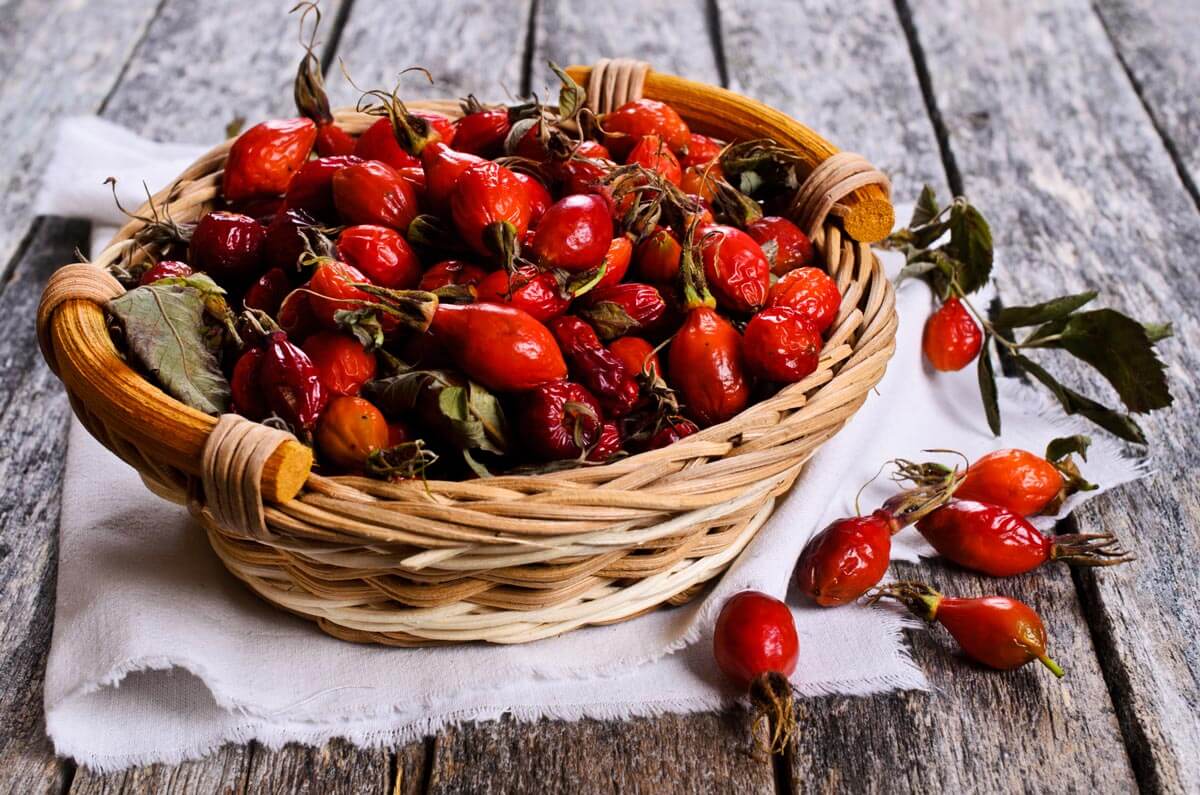This post is filled with all things rosehips for natural medicinal purposes. Including the benefits of rosehips, why we should be growing our own rosehips, harvesting, preparing, drying, and using rosehips medicinally.
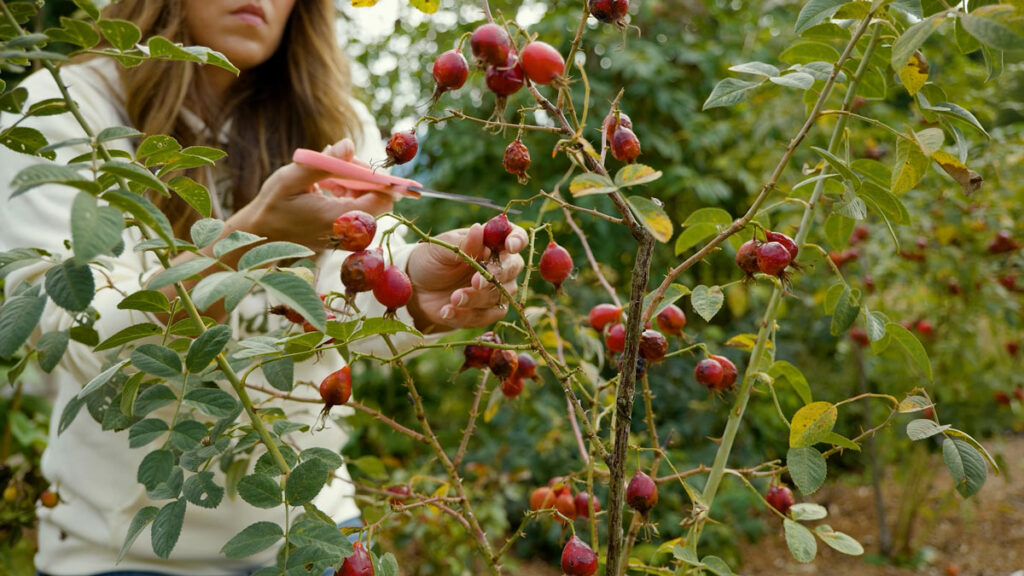
I’m excited to have CeAnne with us from Farmhouse Teas. CeAnne has been with us before discussing how to make your own medicinal tea, and she shows up in the academy from time to time. She also happens to own Farmhouse Teas which is where I source any herbs or teas that I don’t grow and make myself.
She’s also created kits for members of the Pioneering Today Academy for making herbal remedies a breeze in your own home. If you haven’t checked out all Farmhouse Teas has to offer, be sure to do so after listening to this episode.
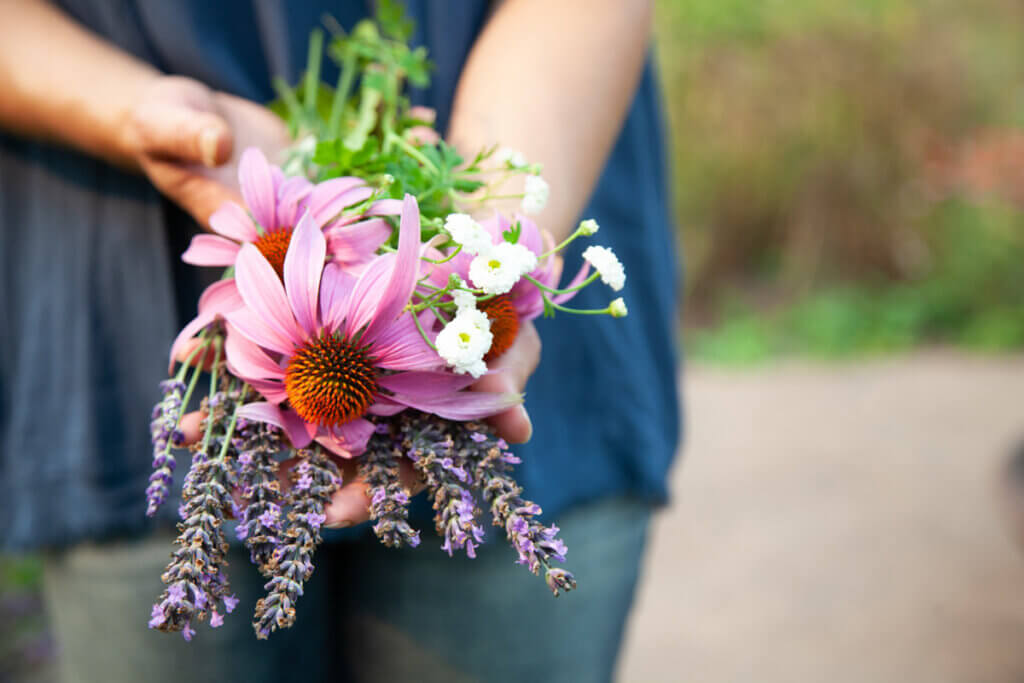
Herbal Course
Before we move on, I have to tell you about my herbal course, Practical Home Herbalism for Cold and Flu Season. Gain the confidence of knowing exactly what remedy to make and having a cabinet stocked full of natural medicine for your family to use at a moment’s notice with this course.
FREE Mini-Herbalism Course
It’s not too late to join my mini herb course (2023). If you want a solid foundation for treating yourself and your family with herbs, sign up for this free course.
But for now, it’s back to the topic at hand. In today’s episode (Pioneering Today Podcast episode #322) we’re discussing all things rosehips, and in the video, I’m sharing how to harvest and preserve rosehips!
Why I Love Roses
Many people don’t think of the medicinal benefits of rosehips. In fact, many people don’t know the bulb left over after a rose bloom is spent can be used for anything at all! Roses are beautiful to look at and, when cared for properly, will grace your garden year after year with beautiful blooms.
Both the petals and the rosehips have many medicinal benefits as well!
It’s important to note that I am not a certified medical practitioner. This post is not intended to diagnose or treat but is for informational purposes only. Please contact your healthcare professional before introducing new herbal and natural remedies into your wellness routine.
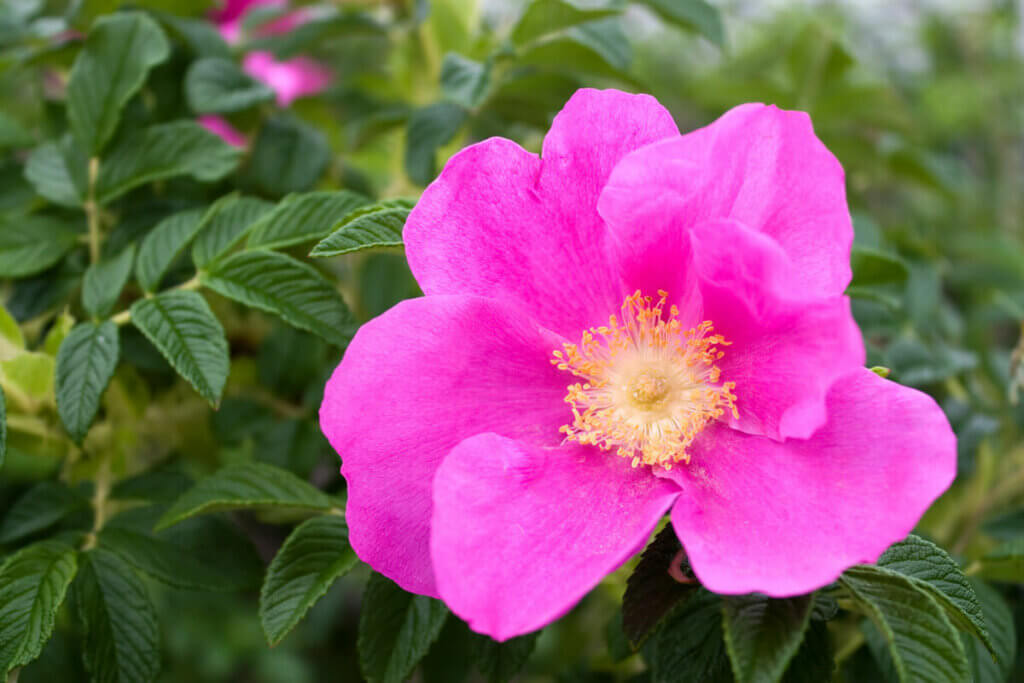
Roses that Produce Rosehips
Not all roses produce rosehips. Many of the more popular roses have been modified for the hips to be bred out. You may notice many rose bushes that don’t leave an orange or red rosehip after the petals have fallen from the bloom.
Here are some rose bushes that will produce rosehips great for medicinal uses:
- Dog-Rose
- Rosa Rubifolia
- Rosa Canina
- Rugosa Rose
- Rosa ‘Fru Dagmar Hastrup
- Rosa Spinosissima
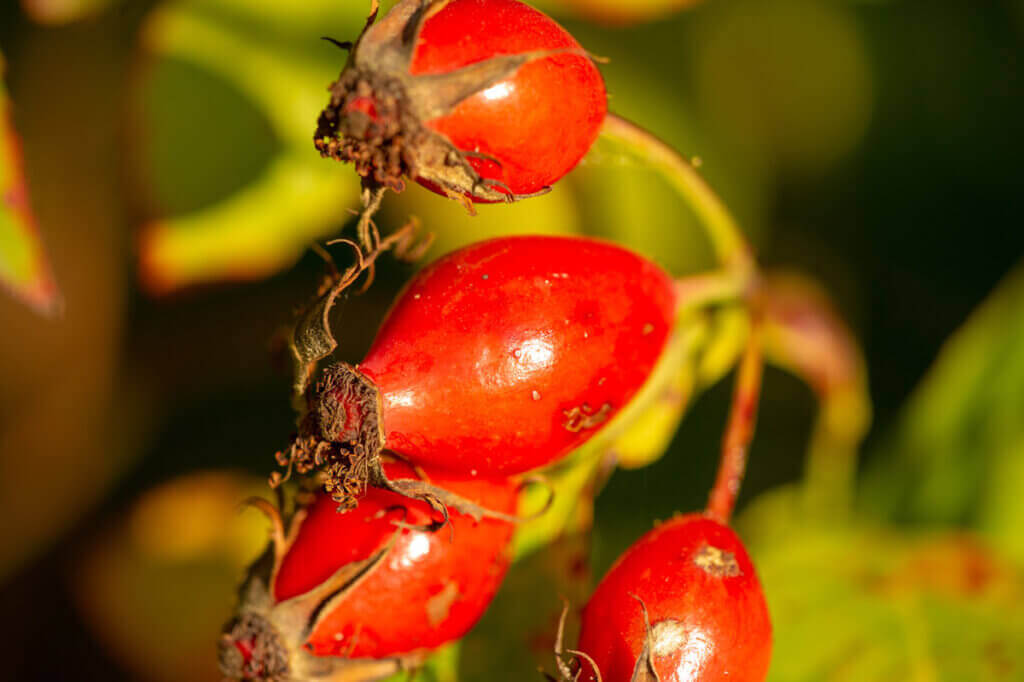
Benefits of Rosehips
There are many benefits of rosehips which makes them a great addition to any medicinal herb garden. Not only are they beautiful, but they pull double duty by being able to use rose petals and the rosehips.
Vitamin C
Rosehips are filled with vitamin C. As we all know, vitamin C is great for immune support and keeping colds and the flu at bay. In fact, one teaspoon of rosehips contains the equivalent amount of vitamin C as eating 5-6 oranges! (Source)
You can also grow rosehips in many more climates than you can grow an orange tree, this is especially helpful for those northern growing zones like Oregon and Washington where CeAnne and I live.
Growing your own vitamin C source is a fantastic way to becoming more self-reliant, so growing roses for their rosehips is much more realistic for me than an orange tree. You’re also getting a lot more vitamin C for the size, making long-term storage much easier as well.
Respiratory Aid
Another benefit of rosehips is that they’re great to consume when dealing with upper respiratory issues. Not just for their vitamin C, but also because they can help with cold symptoms that accompany a cold. (Source)
Inflammation/Joint Pain
Furthermore, rosehips can be a great addition to your herbal medicine cabinet if you deal with joint pain, inflammation or osteoarthritis. (Source)
This is especially true during the colder winter months as most people suffer more with joint pain when the weather is damp and cold.
Important Note: Whenever you’re using any herbal medicine or plant, do adequate research to ensure it won’t interact with any medications you’re on. If you have special health conditions, be sure to check with your medical practitioner.
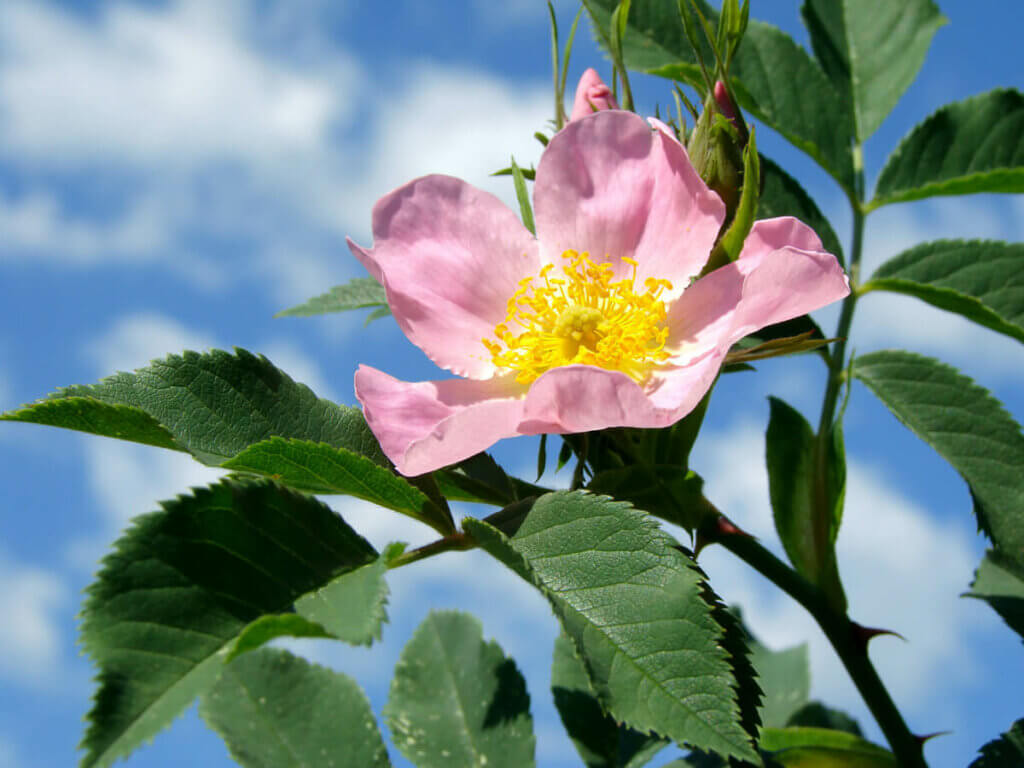
Growing Roses for Rosehips
If I’m growing rosehips for medicinal purposes, you all know that my mind immediately jumps to how many bushes I will need to have enough rosehips to last an entire year for my family. So how many roses will I need to do this?
This is extremely hard to determine because it depends on so many factors: how often you’re using rosehips, the size of your family, what your soil is like, how mature your rose bush is, how much you’re able to harvest per plant, etc.
If you’re on a budget, a safe starting point is to plant between one and three bushes per person to grow enough rosehips for a year. Once your rosehips have matured (which will take many years), you can always reevaluate your needs.
If you have the means to buy more, then by all means plant upwards of five bushes per person in your family. Do take into consideration the full, mature size of the plant. It may be helpful to talk to your local extension office, or even a local nursery.
Buying older, more mature potted rose bushes from a nursery will give you a head start, too! But just know you’ll pay more per bush this way.
You can check out my other posts where I discuss how many berry bushes you’ll need per person here, and you can read how much to plant for a year’s worth of veggies per person here.
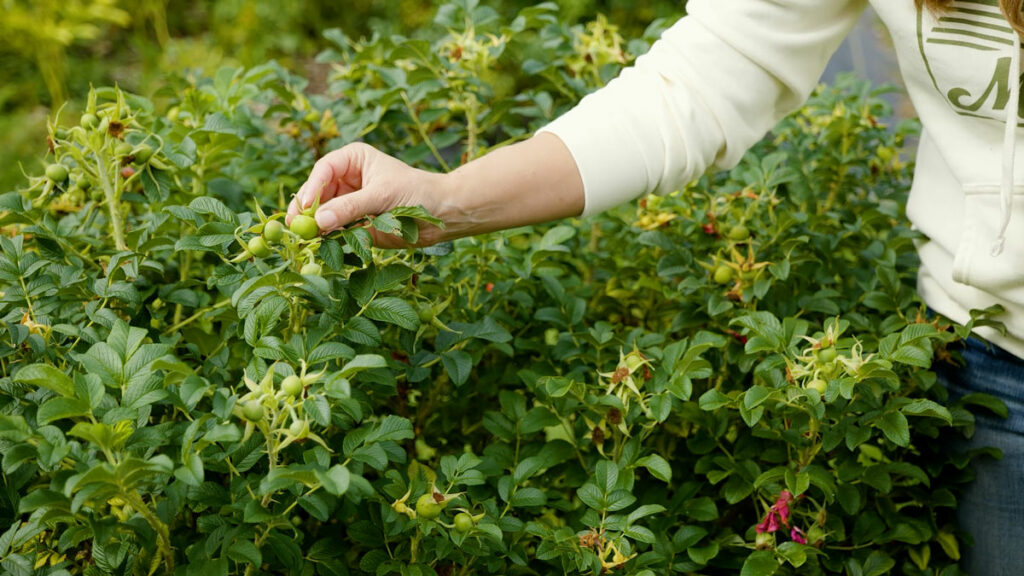
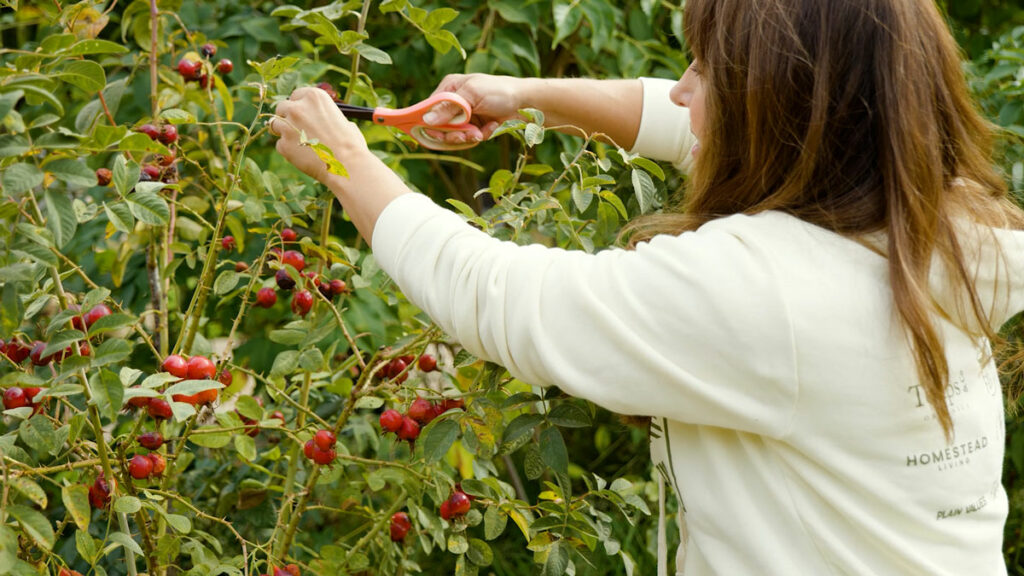
Harvesting Rosehips
It’s best to wait until after the first frost before harvesting rosehips. They’ll be a lot sweeter at this point as well as easier to pick off of the bush.
However, we don’t want any rosehips to go to waste, so if you have roses that bloom earlier in the season, you can still harvest and preserve those rosehips as well.
I happen to have a combination of early and late rosehips. Those that I think will last long enough to go through a frost I’ll leave on the bush. Those that are in their prime earlier, I’ll harvest.
To harvest rosehips simply pluck them off the stem or use kitchen shears if they don’t come off easily.
You may wish to wear long sleeves and gloves, after all, roses are known for their thorns.
Pro Tip: When choosing rosehips, look for those that are firm, bright and plump. You don’t want to preserve rosehips that are already showing signs of deterioration such as blemishes, shriveling, or rotten spots. Whenever we’re preserving, we want to be sure the product is in its prime.
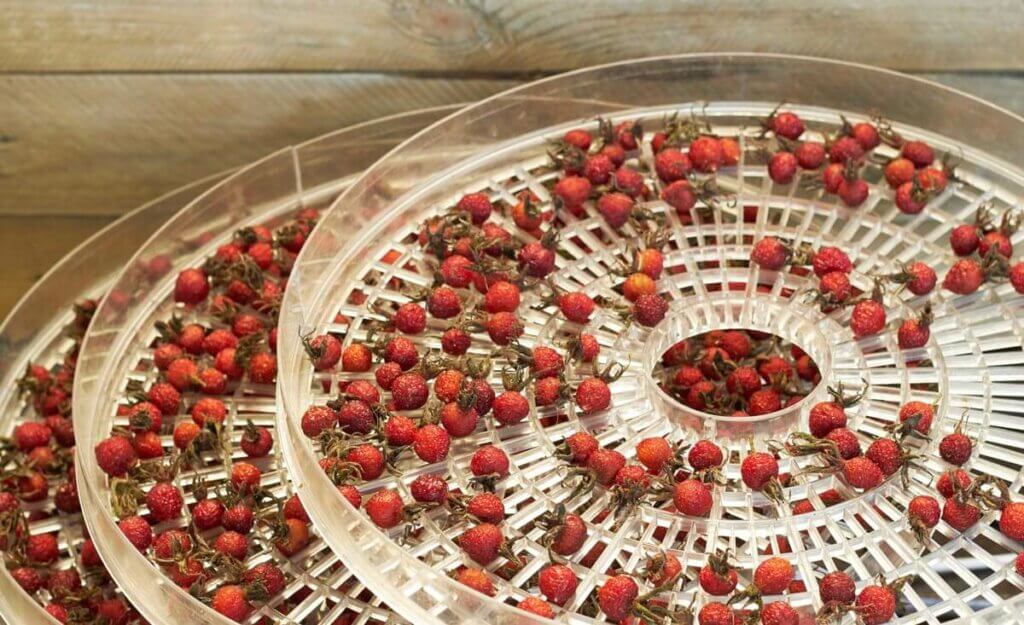
Preserving Rosehips
In order to keep rosehips for long-term storage, you’ll want to dehydrate them. If you’re going to use them within a couple of weeks of picking, you can use them fresh. However, once dry you can store them for up to a year.
Some varieties of rosehips will have larger seeds and depending on how you’re using the rosehips that may be undesirable. I recommend de-seeding the rosehips by cutting them in half and removing the seeds with a spoon. This will also help them dehydrate much faster. (You can save those seeds to make rosehip oil! Read more on that below.)
Furthermore, sometimes rosehips have tiny hairs that can irritate, so this is also another reason to deseed them first. However, if you see no signs of insect damage, you can dehydrate rosehips in their whole form.
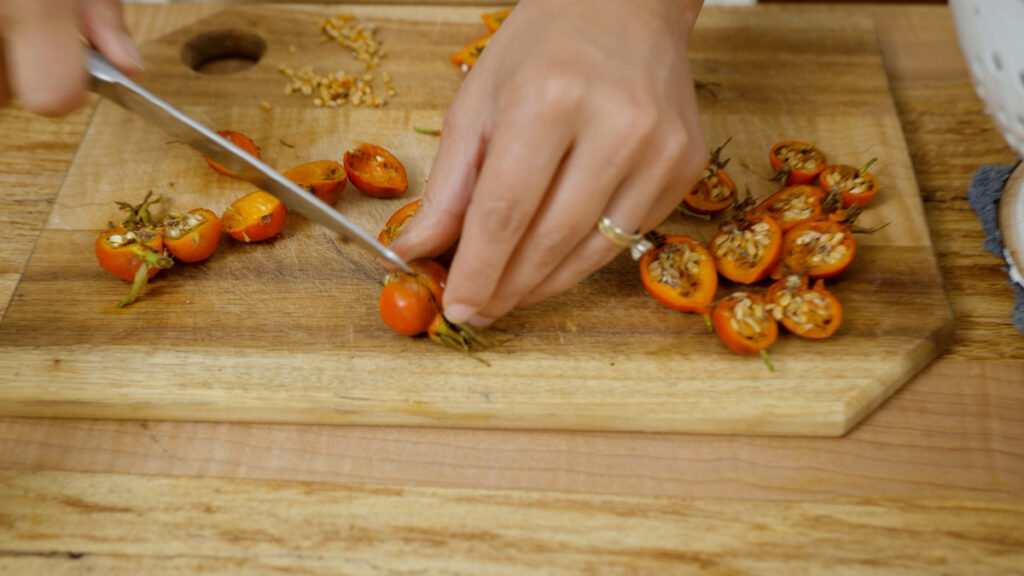
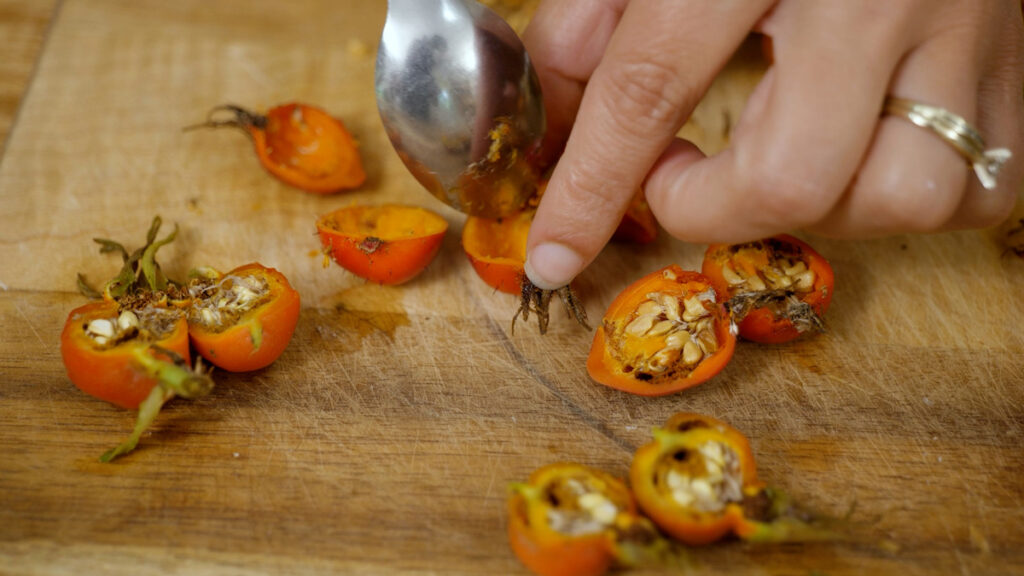
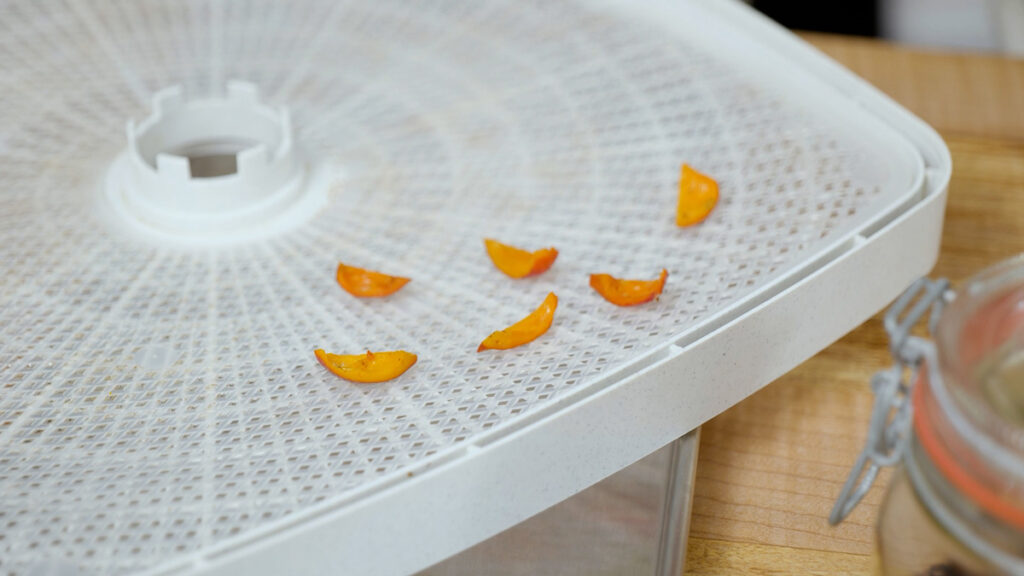
To Dehydrate Rosehips
- Harvest rosehips from the bush – Choosing rosehips that are in their prime. Remember, they’ll taste sweeter if they’ve been able to go through a frost.
- Cut in half and remove the seeds and stem – optional, but ideal for faster dehydration or to inspect the rosehips for signs of insects.
- Lay them out on dehydrator trays – in a single layer.
- Dehydrate until completely dry – Dehydrate the rosehips at 125 degrees F. Don’t go much higher than 145 degrees F. It’s always best to dehydrate at a low enough temperature to preserve it but a high enough temperature to prevent mold. This will vary based on your climate and humidity. If you’re concerned about mold at all, it’s always better to be on the safe side and dehydrate at about 135 degrees F to be sure they’re getting preserved before molding.
- Store in an airtight container (oxygen absorbers will help prolong the shelf-life) – Rosehips, when stored correctly, should last up to a year.
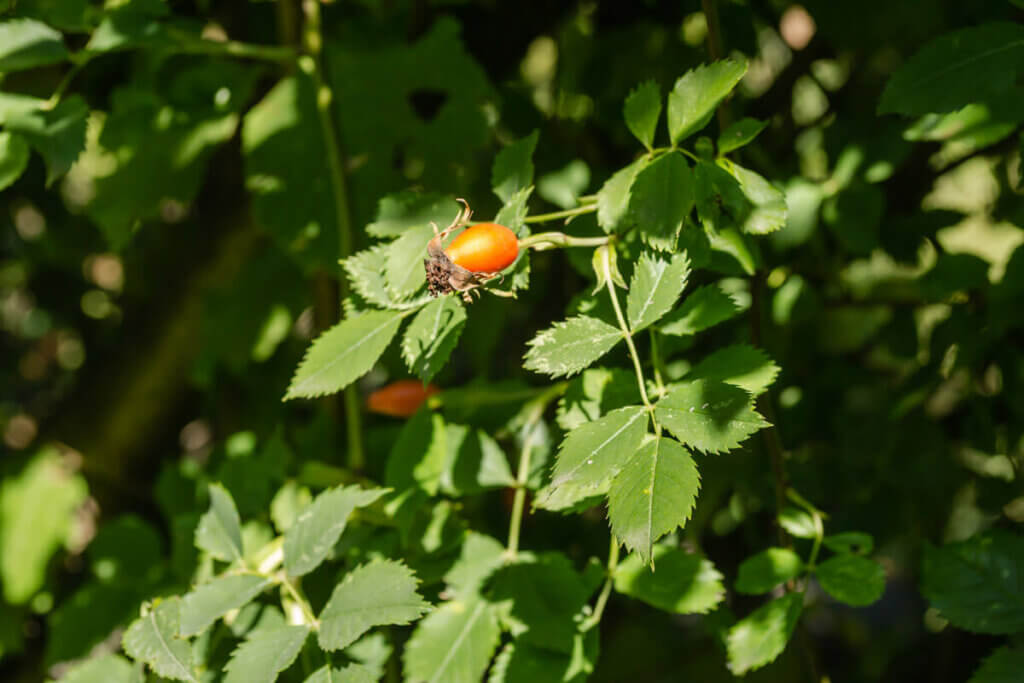
What Do Rosehips Taste Like?
Rosehips have a flavor that is somewhere between hibiscus and cranberry. They’re not quite as sweet as a cranberry, but they would go well with any flavor profile that would go well with a cranberry.
They pair well with the flavors of cinnamon, nutmeg, ginger, and clove. I also love to add rosehips to my homemade elderberry syrup recipe when I want that extra boost of vitamin C.
You can actually grab CeAnne’s elderberry herbal mixture, as well as some of my favorite herbal remedies such as the “Naggin Noggin Tea”, my “First Signs Tincture”, “Fire Cider”, and so much more at Farmhouse Teas!

Best Ways to Use Rosehips
CeAnne’s favorite way to use rosehips is to make tea with them. But there are many ways you can get the benefits of rosehips and all their medicinal properties.
It’s best not to grind your dehydrated rose hips until just before you’re ready to use them. The medicinal properties start to diminish once the surface area is exposed to air, so the smaller the pieces, the quicker they’ll break down.
I like to store my rosehips in pieces (or whole form), then grind up enough for a week or two of tea (or whatever else I’ll be using them for).
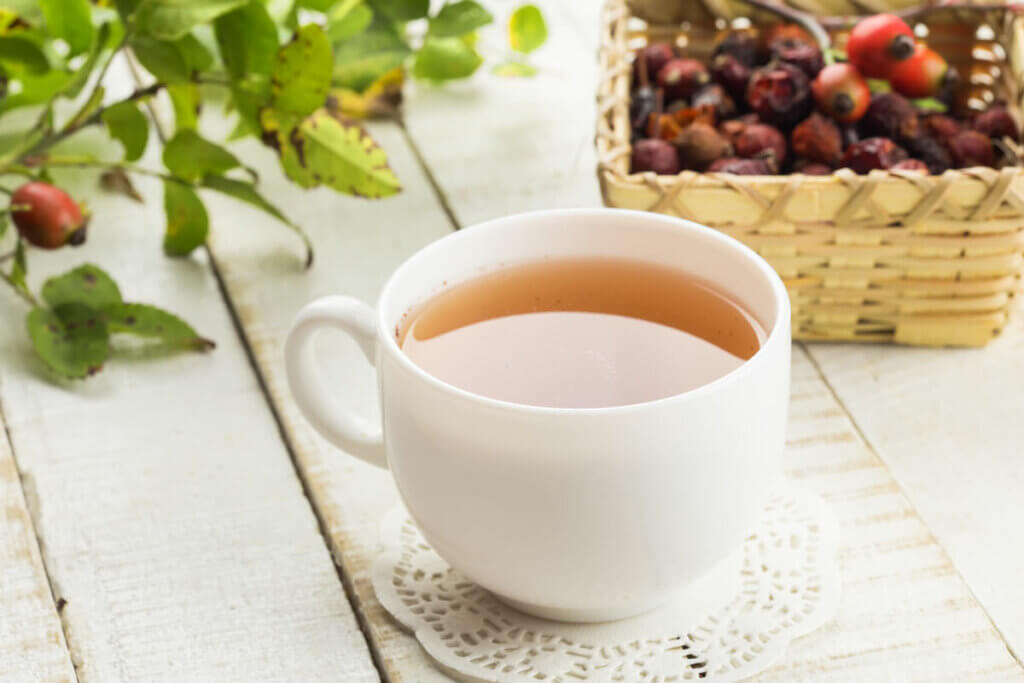
Rosehip Tea
The easiest way to make rosehip tea is just to steep 1 teaspoon of dried rosehips in water on the stovetop at a low simmer (not a boil) for 5-7 minutes. Strain the rosehips out, add honey if desired, sip and enjoy.
If you want to drink rosehip tea more for the medicinal benefits, CeAnne suggests increasing the rosehips to 1 Tablespoon and steeping for 15-20 minutes before drinking.
This may be a bit tart to drink, so you can add honey to help offset the flavor. Or, if you don’t enjoy that strong of a tea, just drink the regular rosehip tea more often to get the same benefits.
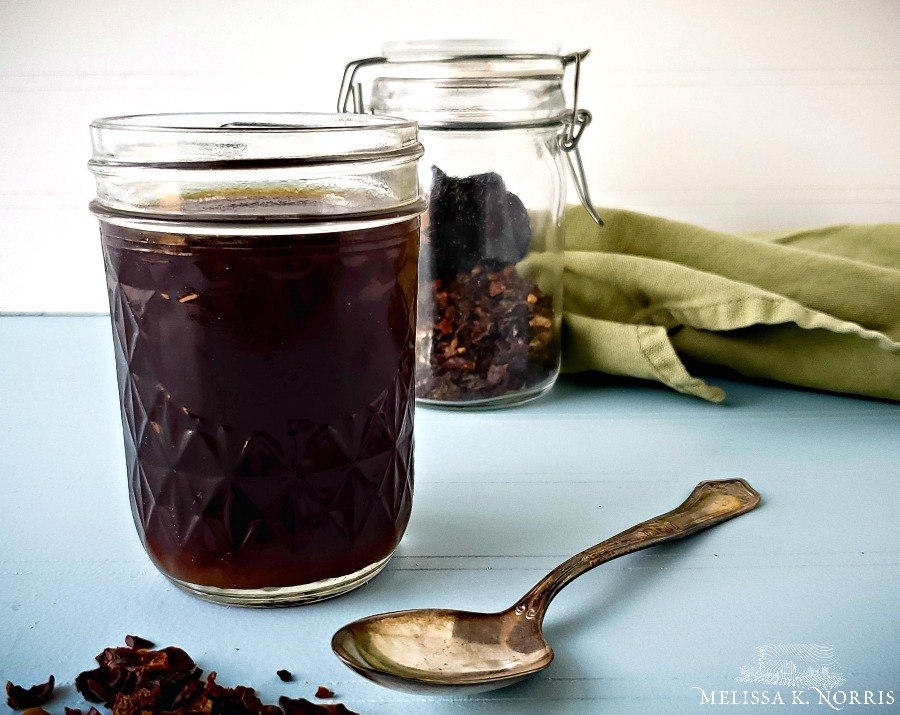
Rosehip Syrup
Rosehip syrup is simply a rosehip tea that you steep in water on the stovetop for 20-25 minutes at a low simmer until the liquid is reduced by half. Then you can add in honey or maple syrup to sweeten it and store it in the refrigerator.
You can use this syrup on pancakes or waffles, or as a sweetener to other teas for a delicious sweet flavor.
Rosehip Tincture
Making a rosehip tincture is the best way to preserve rosehips indefinitely. Simply take your rosehips and steep them in 90 proof alcohol (Everclear Vodka is a popular choice) or glycerin for 6 weeks. Then strain the rosehips out and use a dropper-full in a glass of water any time you need a boost of vitamin C.
Using Rosehips In Cooking
Rosehips are best for cooking if they’re fully hydrated. But you can easily use rosehips in recipes that call for things like raisins or cranberries. Rosehip muffins would be a great treat!
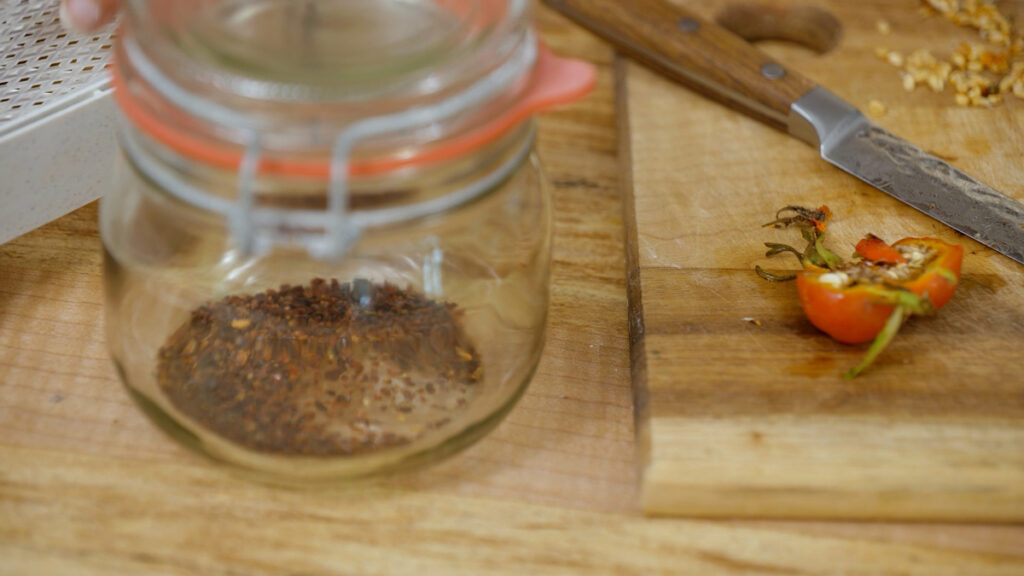
Powdered Rosehips
Sometimes people like to use powdered rosehips for their medicinal benefits, or for mixing into recipes where you can’t steep or use the berries.
If you have a freeze dryer, this will be a very easy process as you simply freeze-dry the rosehips, then pulse them in a food processor until they’re a fine powder.
If you are thinking of dehydrating vs. freeze-drying, they are not the same thing. The end product is very different.
I absolutely adore my freeze dryer from Harvest Right! You can check out the Harvest Right freezer dryers here.
If you don’t have a freeze dryer, you can oftentimes buy rosehip powder. Just be sure it’s from an organic and reputable source (like this organic rosehip powder from Farmhouse Teas).
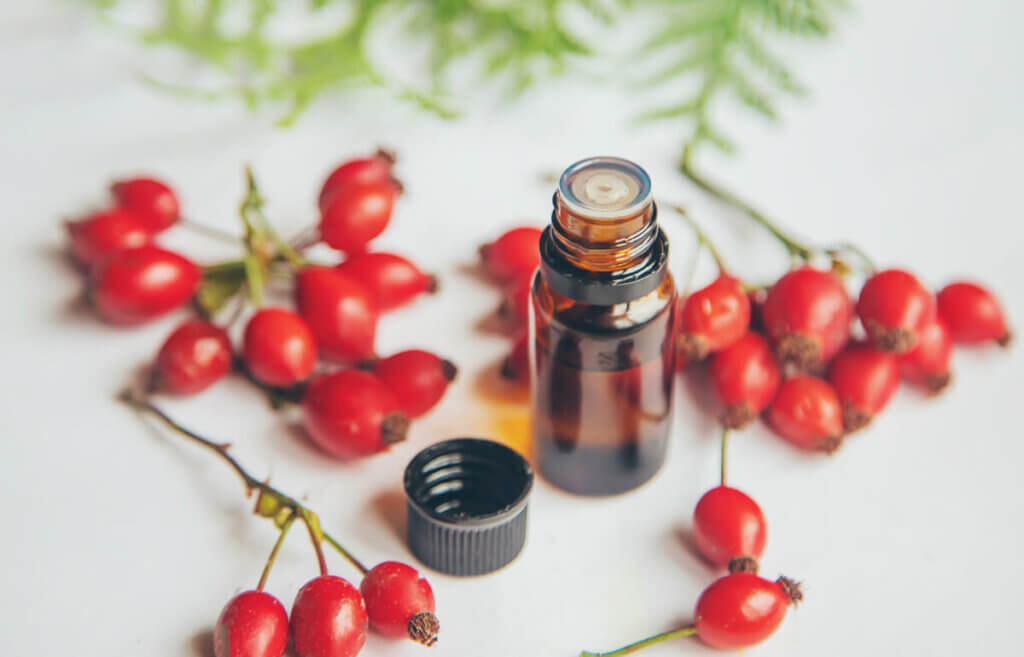
Rosehip Oil
The seeds of the rosehips contain powerful antioxidants and beneficial organisms for anti-inflammatory properties, reducing the signs of wrinkles, speed up healing of skin, and even for helping prevent acne. (Source)
You can make your own rosehip oil by simply steeping mashed fresh or dehydrated rosehips into an oil of your choice (be sure to choose an oil you want to use on your skin, such as jojoba oil).
Mix the rosehips with oil at a ratio of 1:2 and steep in an ovenproof dish at 100 degrees F for 8 hours.
Move the mixture to a dark place to cool down and settle for an additional 2 hours.
Strain the oil from the rosehip mixture and store it in a dark amber glass bottle or dropper vial. You can add in a few drops of vitamin E to help extend the shelf-life, but rosehips already contain vitamin E so this may not be necessary.
Use 2-3 drops of this rosehip oil on your skin daily!

Rosehip Precautions
Be sure to do your own research, but here’s what Dr. Clare, from the Academy of Herbal Medicine has to say about rosehip uses:
Orally, rosehip is used as a supplemental source of dietary vitamin C, for preventing and treating colds, influenza-like infections, infectious diseases, vitamin C deficiencies, fever, increasing immune function during exhaustion, gastric spasms, gastric acid deficiency, preventing gastric mucosal inflammation and gastric ulcers, and as a “stomach tonic” for intestinal diseases. It is also used orally for diarrhea, gallstones, gallbladder ailments, lower urinary tract and kidney disorders, dropsy (edema), gout, aging skin, disorders of uric acid metabolism, arthritis, sciatica, diabetes, increasing peripheral circulation, for reducing thirst, as a laxative and diuretic, and to treat chest ailments.
In foods and in manufacturing, it is used for rosehip tea, jam and soup, and as a natural source of vitamin C
Dr. Clare’s Academy
For the list of adverse reactions, as well as interactions with different herbs and supplements, visit the website here.
CeAnne has a monograph on roses with additional information you can check out as well.
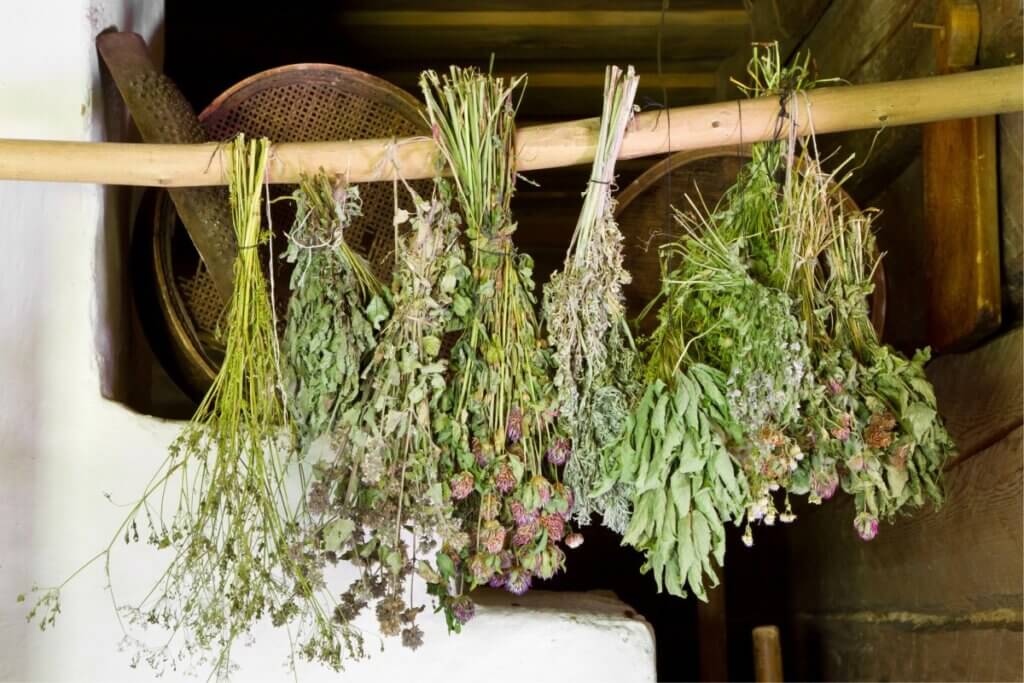
More Posts on Herbs You May Enjoy
- How to Use Herbs and Natural Remedies at Home
- Herbal Home Remedies for Cold and Flu
- 5 Kitchen Herbs You Can Use Medicinally
- Grow a Medicinal Tea Garden with these 8 Herbs
- Medicinal Kitchen Herbs (6 Herbs You Should Grow)
- Best Methods for Drying Herbs for Stronger Medicinal Properties
- Plant These Medicinal Herbs in Fall for Herbs Next Spring
- How to Make Nettle Leaf Tea
[fusebox_transcript]
